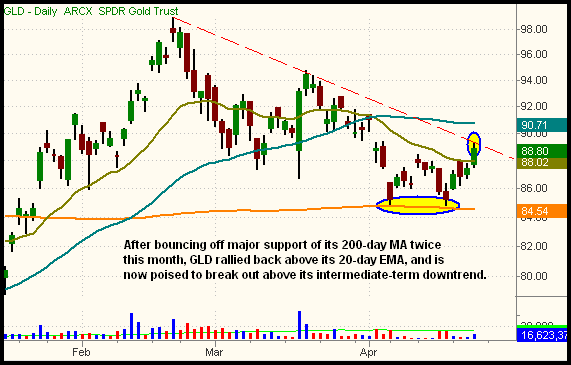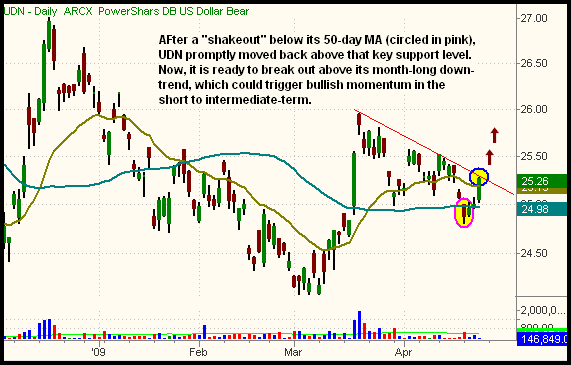|
The Wagner Daily ETF Report For April 24
The major indices see-sawed between positive and negative territory through another choppy, indecisive session yesterday. Like the previous day, buying and selling pressure was roughly in parity, but this time the bulls had the slight edge into the close. The S&P 500 bounced from a 0.9% intraday loss to finish 1.0% higher. The Dow Jones Industrial Average and Nasdaq Composite advanced 0.9% and 0.4% respectively. Finishing lower, small and mid-cap stocks exhibited clear relative weakness for a change. The Russell 2000 lost 0.9%, as the S&P Midcap 400 declined 0.4%. Excepting the laggard small and mid-caps, stocks settled near their intraday highs.
Total volume in the NYSE declined 11%, while volume in the Nasdaq came in 7% lighter than the previous day's level. The lower lower volume gain in the S&P 500 followed a "distribution day," a session of higher volume losses. Though price action has been erratic, the S&P 500's underlying volume pattern over the past two days has favored the bears. The Nasdaq is looking a little better "under the hood." Over the next week, we will remain on the lookout for additional signs of institutional selling that would cause the S&P 500 to have its third "distribution day" this month.
In the April 20 issue of The Wagner Daily, we pointed out that SPDR Gold Trust (GLD) was had twice bounced off major support of its 200-day moving average. After subsequently consolidating just below its 20-day exponential moving average for a couple days, GLD broke out above an area of short-term horizontal price resistance yesterday. Now, GLD is poised to break out above its intermediate-term downtrend line that began with the February 2009 highs. This is shown on the daily chart of GLD below:

A rally and closing price above yesterday's high would cause GLD to break out above its two-month downtrend line, thereby sparking bullish momentum as well. Although a breakout above the downtrend line could enable GLD to climb back to its February high, be aware of resistance of the 50-day moving average just overhead (presently at $90.71). Furthermore, be aware that gold has been atrociously choppy in recent months. False breakouts in this ETF are not uncommon, so bear in mind the need for extra "wiggle room" when setting your stop on a GLD position. For those who prefer the leveraged flavor of ETFs, Gold Double Long (DGP) is the one to check out. You may also want to keep an eye on iShares Silver Trust (SLV), though it's been showing slight relative weakness to GLD.
Yesterday's strength in gold could partially be contributed to weakness in the U.S. dollar, which has started to move lower against most global currencies. As such, PowerShares U.S. Dollar Bear (UDN), a currency ETF tied to an index of global currencies versus the dollar, may be back in play again. After dipping below support of its 50-day moving average earlier this week, UDN promptly snapped back, and is now positioned to break out above a month-long downtrend line. Take a look at the daily chart of UDN below:

Coming into this week, we were already long UDN, but the April 20 "shakeout" caused our stop to trigger by just a few pennies. In hindsight, we may not have given the setup quite enough "wiggle room" below its 50-day moving average to withstand a "stop hunt," which commonly occurs at obvious support levels such as the 50-day moving average. Sometimes that happens, and it's just part of the business. However, one thing that separates professional traders from the rest of the crowd is their ability to calmly and confidently re-enter trades, even at a significantly higher price, as long as the technical setup still looks good.
Rather than re-entering UDN on a breakout above its downtrend line, we prefer the bullish setup in CurrencyShares Japanese Yen (FXY). As illustrated in yesterday's commentary, FXY is poised to breakout above a four-month downtrend line that could enable it to resume its long-term uptrend. In yesterday's session, FXY traded inside the previous day's range before closing slightly higher. This added another day of tight consolidation, which increases the likelihood of a breakout. Regular subscribers should note our detailed trigger, stop, and target prices for this setup below.
Today, U.S. banks will be told how they fared in the new stress tests. The general public is not scheduled to find out until May 4. We believe the stock market's erratic price action of the past two days is largely due to jitters about the pending financial stress tests. As such, be prepared for more chop and whippy price action in today's session. Although we still anticipate the major indices to retrace down to their 50-day moving averages in the short-term, it would not be totally shocking if stocks attempted to break out above their recent highs first. But the reality is that a substantial broad market pullback would technically be healthier than another breakout right now. If stocks make another run to new highs without correcting first, the breakout would more than likely be short-lived.
Open ETF positions:
Long - FXP, SDS
Short - (none, but both FXP and SDS are inversely correlated ETFs)
Deron Wagner is the Founder and Head Trader of both Morpheus Capital LP, a U.S. hedge fund, and MorpheusTrading.com, a trader education firm.
|